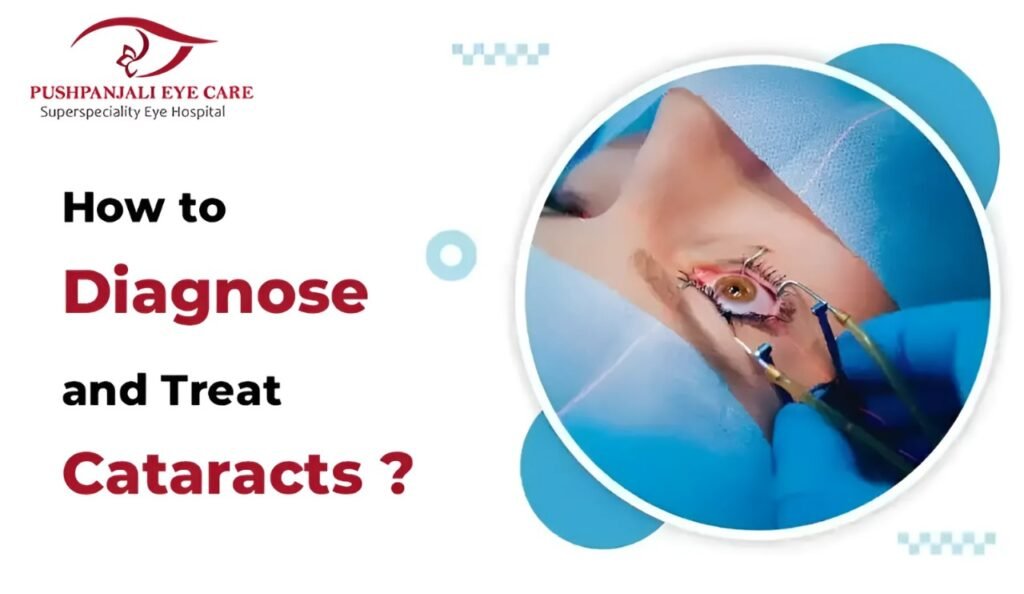Pushpanjali Eye Care, Golpark, Kolkata-700029
Pushpanjali Eye Care, Golpark, Kolkata-700029

By PushpanjaliEyeCare
07.05.2024
Hello Reader!
Welcome to the blog page of Pushpanjali Eye Care, one of the best eye hospitals in Kolkata.
Cataracts are a common eye condition that affects millions of people worldwide, leading to blurred vision and, if left untreated, eventual blindness. At Pushpanjali Eye Care, the premier eye hospital in Kolkata, we specialize in the diagnosis and treatment of cataracts. In this comprehensive guide, we’ll delve into the diagnosis process for cataracts, outlining the steps involved and the advanced techniques used at our facility.

The cornerstone of cataract diagnosis lies in the thoroughness of our comprehensive eye examination. Led by our experienced ophthalmologists, this examination is designed to leave no stone unturned in evaluating the health of your eyes. Through a series of tests and evaluations, your eye doctor meticulously assesses various aspects of your vision and ocular structures. This includes scrutinizing your visual acuity, scrutinizing the lens for any signs of cloudiness indicative of cataract formation, and examining other ocular structures for potential abnormalities associated with cataracts.

A pivotal component of the diagnosis process is the visual acuity test, also known as the eye chart test. This test serves as a fundamental measure of your visual clarity at different distances. By gauging your ability to read letters or symbols on an eye chart, our ophthalmologists can ascertain the extent to which cataracts have impaired your vision, guiding subsequent treatment decisions.
Employing advanced techniques, such as slit-lamp examination, allows us to delve deeper into the intricacies of your eye’s anterior segment, including the lens. By directing a focused beam of light onto your eye, our ophthalmologists can magnify and scrutinize the lens for telltale signs of cloudiness or opacity characteristic of cataracts. This meticulous examination aids in precisely pinpointing the location and severity of cataract formation, laying the groundwork for personalized treatment strategies.
To gain a comprehensive view of your eye’s internal structures, a dilated eye examination is often performed. This involves administering specialized eye drops to dilate your pupils, facilitating a wider aperture for examination. With your pupils dilated, our ophthalmologists can conduct a more thorough assessment of the lens and other ocular structures, enabling them to accurately gauge the severity and location of cataracts.

In certain cases, additional diagnostic tests may be warranted to obtain a more nuanced understanding of the cataract’s characteristics and progression. Techniques such as optical coherence tomography (OCT) or ultrasound imaging may be employed to obtain detailed images of the lens and assess the extent of cataract formation. These advanced diagnostic modalities complement our comprehensive approach to cataract diagnosis, ensuring that no aspect of your eye health goes unnoticed.
Following the precise diagnosis of cataracts by our adept team at Pushpanjali Eye Care, a tailored treatment plan is meticulously crafted to address your individual needs and the severity of your condition. Our esteemed ophthalmologists will guide you through the available treatment options, ensuring informed decision-making and optimal visual outcomes.
Cataract surgery stands as the gold standard in the treatment of cataracts, offering unparalleled effectiveness in restoring vision compromised by the cloudy lens. This transformative procedure involves the surgical removal of the clouded lens from the eye, followed by the implantation of a clear artificial intraocular lens (IOL). At Pushpanjali Eye Care, we pride ourselves on our commitment to excellence in cataract surgery, leveraging advanced techniques and state-of-the-art technology to deliver superior outcomes for our patients.
Phacoemulsification represents a groundbreaking advancement in cataract surgery, characterized by its minimally invasive nature and precision-driven approach. During this procedure, a specialized ultrasonic device is utilized to fragment the cloudy lens into tiny fragments, which are then gently suctioned out of the eye. This meticulous process ensures minimal trauma to the surrounding tissues and facilitates rapid visual recovery, allowing patients to resume their daily activities with minimal downtime.
Pushing the boundaries of innovation, femtosecond laser-assisted cataract surgery heralds a new era in the field of ophthalmology. This cutting-edge technique harnesses the power of femtosecond laser technology to perform key steps of the cataract surgery procedure with unparalleled precision and reproducibility. By utilizing laser energy to create precise incisions, fragment the cataractous lens, and facilitate capsulotomy, this advanced approach enhances surgical predictability and optimizes visual outcomes. At Pushpanjali Eye Care, we are proud to offer femtosecond laser-assisted cataract surgery as part of our comprehensive cataract treatment repertoire, ensuring our patients receive the highest standard of care.
At Pushpanjali Eye Care, the leading eye hospital in Kolkata, we are dedicated to providing comprehensive eye care services, including the diagnosis and treatment of cataracts. If you are experiencing symptoms of cataracts or have concerns about your eye health, don’t hesitate to schedule a consultation with our experienced ophthalmologists. With our expertise, we are committed to helping you achieve clear vision and optimal eye health.